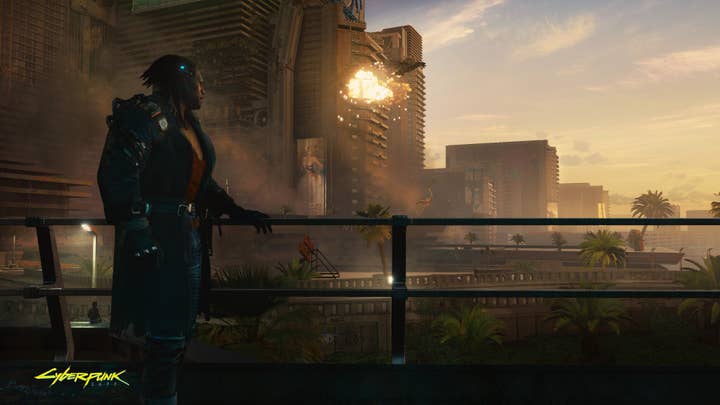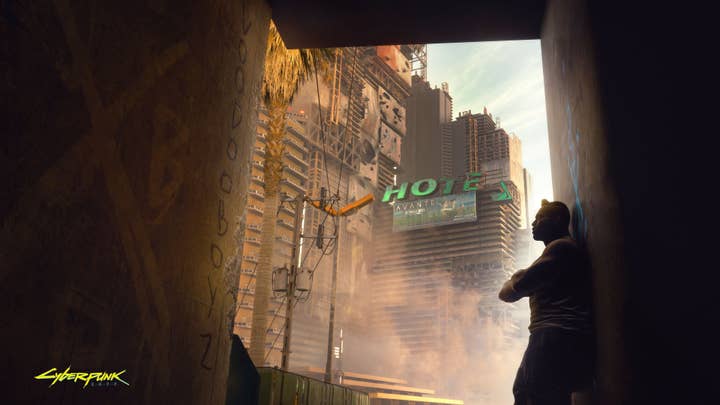The 57 years of unseen work that built Cyberpunk 2077's Night City
We speak to CD Projekt Red's Marthe Jonkers about the design process behind creating a unique vision of the future
The very word 'cyberpunk' paints a very distinct picture of the future. Mechanically augmented humans. Hover cars. Beefier guns. An abundance of neon and/or holographic signs. And probably a lot of rainy night time scenes.
It's an aesthetic that has been honed by countless movies, anime and games over the past few decades, so how CD Projekt Red make its highly anticipated action RPG Cyberpunk 2077 stand out in the genre?
Concept art coordinator Marthe Jonkers tells us it all started with the tabletop game on which the project is based: Mike Pondsmith's Cyberpunk 2020. Of course, the Polish developer's game is set almost 60 years after this -- a lot can change over that time. So for Jonkers and her team, it was very important to fill in the blanks.
"Our team has probably seen every cyberpunk movie that exists, we've read the books, and we know we have this all in our head," she tells GamesIndustry.biz. "We know the whole canon of cyberpunk. But we still wanted to create something that was really fresh and new.

"We did that by really tapping into the lore that was created in the '80s with Cyberpunk 2020, and also taking this timeline -- between 2020 and 2077 -- and letting those events that happened in-between define the way that Night City will look in 2077."
Jonkers and her fellow artists even began thinking about the fashions and styles that came and went during the missing 57 years, from architecture and clothing to vehicle and weapon design. Imagining the history of Night City "was really part of the backbone in how to proceed."
"Really early in the project, we were thinking about it. Our art directors mostly were really trying to nail down this sort of visual background for Night City. And that we use really as a guideline for the visual styles in the game, and you will actually see a lot of old styles reflected in the fashion and the weapon designs."
The artist observes that no city is ever defined by one style -- it's always a mix of those that came before (In fact, CD Projekt Red defined four separate styles that dominated the missing decades, but more on that in a bit.)
"We know the whole canon of cyberpunk. But we still wanted to create something that was really fresh and new."
Even individual areas of a metropolis will have their own unique features and aesthetics that aren't found anywhere else in the urban sprawl. The world of Cyberpunk 2077 is split into nine distinct districts, each of which is built with a different mix of those four styles.
Pacifica, the region featured in the gameplay demo shown behind closed doors at Gamescom is a prime example. The area was originally planned as a resort area, with gaudy hotels towering over the coastline, but as money for these projects dried up, the corporations abandoned them, leaving the district to fall into disrepair.
Meanwhile, a series of natural disasters rendered Haiti uninhabitable, and many of its survivors found their way to Night City, settling in Pacifica. This mass influx brought with it a different culture that can even be seen in the graffiti found around the area.

"[Every district] has this story of which people came to live there and why, and then we added this extra layer of their own visual language to it, to show you all the layers of history in this district," Jonkers explains.
"When you see a building that's sort of pink with these soft edges, you know it was built when people had more money. It's telling you a story about the background of the city, and gives an extra layer of believability."
"So in Pacifica, you will see a lot of art that's really connected to the Voodoo Boys, the gang that's in control there. And it's really cool because when you drive around the city and you see these different art styles, you can actually recognise the type of people that lived there, or which gang is in charge there."
Naturally, this means elsewhere in the city you'll see influences from other cultures, including Japan -- something often associated with the cyberpunk genre. Yet the location of Night City was just as important an influence. While so much of this fiction is set around Tokyo or other Asian cities, Cyberpunk 2077's metropolis is set on the California coast, which also helps the game and its fiction stand out.
"When we showed the demo last year, people were surprised at first that it was so sunny," Jonkers recalls. "They expected rainy, dark cyberpunk but you can make a cyberpunk city in California. Of course it will rain there, because we have a weather system, and it will also be night, but we are really trying to get this fresh take on cyberpunk."
As mentioned, the foundation of Night City's design is built around four distinct visual styles, each of which tells the story of what happened to the world between 2020 and 2027. The first is called Entropism, developed in a period of time when there was mass poverty and people were struggling.
"They expected rainy, dark cyberpunk but you can make a cyberpunk city in California"
"Because people were poor, they wouldn't make very colourful things -- they would actually make art with subdued colour palettes," Jonkers says. "The designs from that era are very practical, more about practicality than whether it looks nice or is decorated."
So, if you spot a blander, bulkier vehicle or an unremarkable building, the likelihood is because it was built during the era of Entropism.
Next came the Kitsch style, evolving as the economy recovered. People's return to better fortunes, improved their outlook on life and injected some much needed colour into the world.
This was countered by the third era where the rise and domination of corporations led to the Neomilitarism style. Everything became slick and smooth, metal became the most commonly used material, often kept a cold, corporate black.
Finally, there's Neokitsch, developed in the more recent years before the events of Cyberpunk 2077. The chasm between the rich and the poor became wider, and the rich indulged in more colourful showcases of their wealth.

"In Night City, the natural elements are starting to get more and more rare," Jonkers says. "Most animals are becoming extinct, and it's hard to acquire wood. So if you see someone walking around with some animal print on their body, they're pretty rich -- it's a symbol of their wealth. The buildings of the super-rich use a lot of wood, marble and stuff like that, because most people can't afford it.
She continues: "There are layers to the design of Night City and all its inhabitants, so when you drive around and you see a building that's sort of pink with these soft edges, and the windows are sort of soft shaped, you know that this is kitsch style, and you know that was built in that period of time where people had more money back then. It's telling you a story about the background of the city, and gives an extra layer of believability.
"That was really, really important to us, to make a unique take on Cyberpunk. And I really like that when people see screenshots of our game, they recognise it as our style."
Clearly, an admirable amount of effort has gone into the worldbuilding -- but is such effort required? Will players really notice the Neomilitaristic elements of the cars chasing them, or the Entropic make-up of the ghetto they're gunning their way through?
"Some players will probably maybe want to focus on the action, but at CD Projekt Red we are really about storytelling," Jonkers concludes. "That's the thing we do. We like to tell stories, we like to tell very deep narrative experiences. And we often make open worlds, it's just what we love to do, so we try to push that in this game.
"If you're going to explore Night City, we'll make sure that it's full of stories for you to explore."









